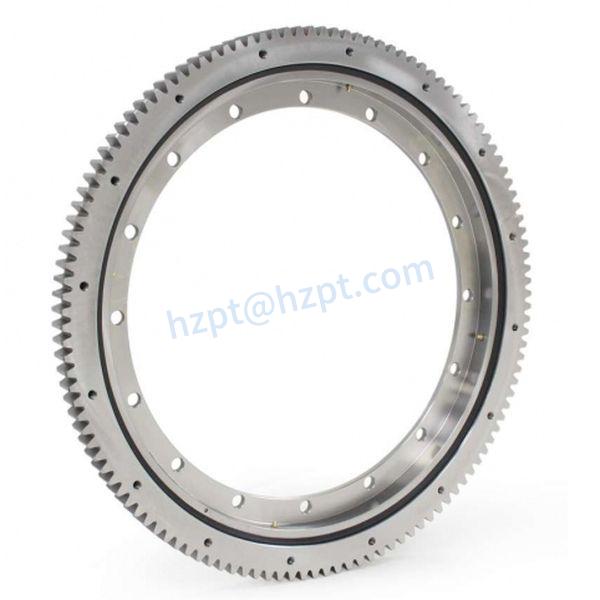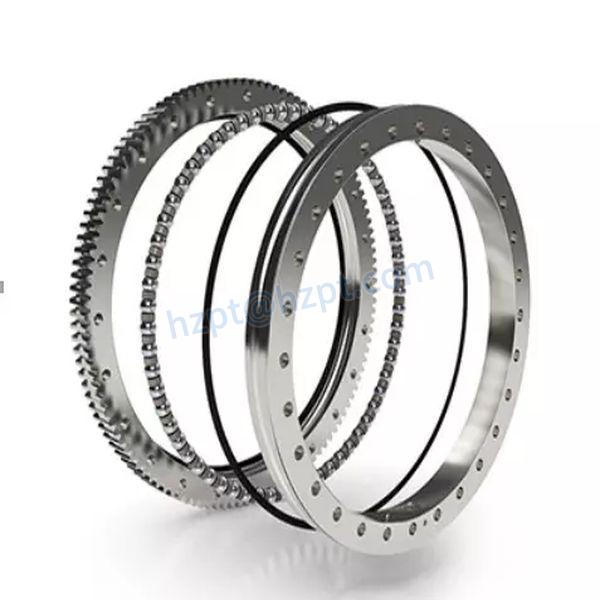Product Description
HangZhou AUTO Bearing Co.,Ltd. slewing ring bearing capacity few types: single-row 4 point contact ball slewing bearing, single-row cross roller slewing bearing, double row different ball diameter slewing bearing, three-row cylindrical roller slewing bearing and roller&ball combination slewing bearing. All of these slewing ring bearings can be divided into bearings without gears, bearings with internal gears and bearings with external gears.
Products widely used for engineering machinery,recreation facilities, welding equipment, port machinery, environmental protection equipment,marine equipment,solar tracking system and so on.Mainly export to Europe,West Africa,South America,Oceania,Southeast Asia etc.
Processing of size range: 120 – 12000mm
Material: 42CrMo4 , C45 , 50Mn.
Company
HangZhou Auto Bearing Co., Ltd. is located in the industrial park of HangZhou,which is 1 of the 4 great ancient capitals of China.Our company is the member of China Bearing Industry Association,cooperating with State Quality Supervision and Testing Center for bearing.Our company is a professional bearing manufacturer which integrated with research ,development and marketing services.
Our major products include deep groove ball bearing, spherical roller bearing, slewing ring, crossed roller bearing and other all kinds of high precision bearings.Our products are widely applied to motor industry,mining metallurgy,wind power generation,petroleum drilling,automobile and motorcycle etc..
Our company not only possesses advanced bearing manufacturing equipments and international first-class measuring instruments, but also has strong strength of manufacturing, inspecting and testing the high precision and reliability bearings.Each process is in strict accordance with the ISO9001 quality management system,which effectively guarantees the precise of products and stability of the performance. AUTO bearings are mainly exported to the United states,South Korea,Europe,etc., which have reached the high level of foreign similar products.
The soul of our business culture is [Detail makes competitive, innovation makes first-class”.We believe the production and management philosophy of [quality wins ,casting competitive products”.The company adheres to the zero-defect quality management for meeting customer requirements.
Packing
A. plastic box & outer carton & pallets
B. plastic bag & box & carton & pallet
C. tube package & middle box & carton & pallet
D. Depends on your needs
Delivery
A. Most orders will be shipped within 3-5 days of payment being received.
B. Samples will be shipped by cov2urier as FedEx,UPS,DHL,etc.
Thank you very much for taking time to view our company’s website. If you are interested in this product, please feel free to contact us. We are always here.
/* January 22, 2571 19:08:37 */!function(){function s(e,r){var a,o={};try{e&&e.split(“,”).forEach(function(e,t){e&&(a=e.match(/(.*?):(.*)$/))&&1
| Contact Angle: | 60° |
|---|---|
| Aligning: | Non-Aligning Bearing |
| Separated: | Separated |
| Rows Number: | Single |
| Load Direction: | Radial Bearing |
| Material: | Bearing Steel |
| Customization: |
Available
| Customized Request |
|---|

Can you Explain the Concept of Axial and Radial Load Capacity in Slewing Bearings?
The axial and radial load capacities are fundamental parameters that define the ability of slewing bearings to withstand different types of loads along different directions. Here’s an explanation of these concepts:
- Axial Load Capacity:
The axial load capacity of a slewing bearing refers to its ability to withstand loads that act parallel to the axis of rotation. In other words, it’s the maximum force that can be applied along the vertical or horizontal axis without causing significant deformation or failure of the bearing components.
For example, in applications where the bearing supports vertical loads like those encountered in cranes or excavators, the axial load capacity is crucial to ensure the stability and safety of the equipment. Slewing bearings designed for high axial load capacities have sturdy components and optimized raceway profiles to distribute the load evenly and prevent stress concentrations.
- Radial Load Capacity:
The radial load capacity of a slewing bearing pertains to its ability to withstand loads that act perpendicular to the axis of rotation. These loads are directed toward or away from the center of the bearing. Radial loads can result from weight, force, or moments acting perpendicular to the axis of rotation.
For instance, in applications involving cantilevered structures, the radial load capacity is essential to support the bending moments and forces applied to the bearing. Slewing bearings with high radial load capacities are designed to handle these loads without excessive deformation, minimizing wear and maintaining operational integrity.
- Combined Load Situations:
Real-world applications often involve combinations of axial and radial loads. Slewing bearings must be selected and designed to handle these combined loads effectively. Engineers consider both axial and radial load capacities to ensure that the bearing can safely operate under the expected loading conditions.
Manufacturers provide load rating charts and data that specify the maximum axial and radial loads a slewing bearing can handle. Engineers use this information to make informed decisions about bearing selection for various applications.
In summary, the axial and radial load capacities of slewing bearings are essential parameters that determine their ability to withstand specific types of loads in various directions. Proper consideration of these capacities ensures safe and reliable operation in diverse applications.

What are the Common Maintenance Practices for Ensuring the Durability of Slewing Bearings?
Maintaining slewing bearings is crucial for ensuring their longevity and optimal performance. Here are some common maintenance practices to enhance the durability of slewing bearings:
- Regular Inspection:
Perform routine visual inspections to check for signs of wear, corrosion, and damage. Inspect seals, lubrication levels, and any unusual noises or vibrations during operation.
- Lubrication:
Follow the manufacturer’s guidelines for lubrication intervals and use appropriate lubricants. Lubricate the bearings to ensure smooth operation, reduce friction, and prevent wear.
- Seal Maintenance:
Inspect and maintain seals to prevent the ingress of contaminants such as dust, dirt, and moisture. Damaged or worn seals should be replaced promptly.
- Cleaning:
Regularly clean the bearing and its surrounding area to remove dirt, debris, and contaminants that could affect performance. Keep the bearing environment as clean as possible.
- Environmental Protection:
If the bearings are exposed to harsh conditions, consider using protective covers or shields to prevent direct exposure to elements like water, chemicals, and abrasive materials.
- Alignment and Mounting:
Ensure proper alignment during installation to prevent unnecessary stress on the bearing. Accurate mounting reduces the risk of misalignment-related failures.
- Torque Monitoring:
If the bearing has gears, regularly monitor and maintain the torque levels to prevent overloading and premature wear.
- Load Distribution:
Operate the machinery within the specified load limits to avoid overloading the bearing, which can lead to fatigue and failure.
- Replacement of Worn Components:
If any components, such as seals or lubrication fittings, show signs of wear, replace them promptly to maintain the integrity of the bearing system.
- Documentation:
Maintain records of maintenance activities, including lubrication schedules, inspections, and any repairs or replacements. This documentation helps track the bearing’s history and aids in decision-making.
- Training:
Ensure that maintenance personnel are adequately trained to carry out proper inspection, lubrication, and maintenance procedures.
By implementing these maintenance practices, you can maximize the service life of slewing bearings, minimize downtime, and maintain consistent machinery performance.

Can you Explain the Differences Between Single-Row and Double-Row Slewing Bearings?
Single-row and double-row slewing bearings are two common configurations with distinct characteristics. Here are the key differences between them:
- Design:
A single-row slewing bearing consists of one row of rolling elements positioned between the inner and outer rings. In contrast, a double-row slewing bearing has two rows of rolling elements.
- Load-Carrying Capacity:
Double-row slewing bearings generally have a higher load-carrying capacity compared to single-row bearings. The presence of two rows of rolling elements enables them to handle heavier axial, radial, and moment loads.
- Stiffness:
Double-row bearings offer higher stiffness due to the additional row of rolling elements. This stiffness can be advantageous in applications where precise positioning and resistance to deflection are crucial.
- Compactness:
Single-row slewing bearings are typically more compact and have a smaller profile compared to double-row bearings. This compact design can be advantageous in applications with limited space.
- Cost:
Single-row slewing bearings are generally more cost-effective compared to double-row bearings. The increased complexity and higher load capacity of double-row bearings can result in higher manufacturing costs.
- Applications:
Single-row slewing bearings are suitable for applications with moderate loads and rotational requirements, where compactness is important. Examples include small cranes, excavators, and material handling equipment. Double-row slewing bearings are often used in larger and heavier machinery, such as construction equipment, wind turbines, and heavy-duty cranes.
- Performance Trade-offs:
While double-row bearings offer higher load capacity and stiffness, they may also introduce higher friction and slightly reduced rotational efficiency compared to single-row bearings due to the presence of additional rolling elements.
In summary, the choice between single-row and double-row slewing bearings depends on factors like load requirements, available space, and desired stiffness. Each configuration has its own advantages and trade-offs, allowing engineers to tailor their selection to the specific needs of the application.


editor by CX 2024-04-03
by
Tags:
Leave a Reply